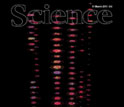News Release 11-048
Study Finds Primates Age Gracefully
Chimpanzees, gorillas and other primate, including humans, share similar aging rates and mortality gender gap

Data from seven species of wild primates shows human aging patterns are not strikingly different.
March 10, 2011
This material is available primarily for archival purposes. Telephone numbers or other contact information may be out of date; please see current contact information at media contacts.
A new study says chimps, gorillas and other primates grow old gracefully much like humans. The findings come from the first-ever multi-species comparison of primate aging patterns reported in the March 11 issue of Science.
It was long thought that humans, who have relatively long life spans, age more slowly than other animals. But new research funded by the National Science Foundation's Division of Environmental Biology suggests the pace of human aging may not be so unique after all.
We had good reason to think human aging was unique, said co-author Anne Bronikowski of Iowa State University. Humans, for example, live longer than many animals with some exceptions--parrots, seabirds, clams and tortoises. But humans are the longest-lived primates.
"Humans live for many more years past our reproductive prime," Bronikowski said. "If we were like other mammals, we would start dying fairly rapidly after we reach mid-life. But we don't."
Bronikowski is one of 11 biologists and anthropologists whose research figured into the study.
"There's been this argument in the scientific literature for a long time that human aging was unique, but we didn't have data on aging in wild primates besides chimps until recently," said another co-author Susan Alberts, a Duke University biologist.
The researchers combined data from long-term studies of seven species of wild primates: capuchin monkeys from Costa Rica, muriqui monkeys from Brazil, baboons and blue monkeys from Kenya, chimpanzees from Tanzania, gorillas from Rwanda, and sifaka lemurs from Madagascar.
The work focused on the risk of dying. When researchers compared human aging rates--measured as the rate at which mortality risk increases with age--to similar data for nearly 3,000 individual monkeys, apes, and lemurs. The human data fell neatly within the primate continuum.
"Human patterns are not strikingly different, even though wild primates experience sources of mortality from which humans may be protected," the authors write in Science.
The results also confirm a pattern observed in humans and elsewhere in the animal kingdom: as males age, they die sooner than their female counterparts. In primates, the mortality gap between males and females is narrowest for the species with the least amount of male-male aggression--a monkey called the muriqui--the researchers report.
"Muriquis are the only species in our sample in which males do not compete overtly with one another for access to mates," said co-author Karen Strier, an anthropologist at the University of Wisconsin who has studied muriquis since 1982. The results suggest the reason why males of other species die faster than females may be the stress and strain of competition, the authors say.
Modern medicine is helping humans live longer than ever before, the researchers note. "Yet we still don't know what governs maximum life span," Alberts said. She is also the associate director of the NSF-funded National Evolutionary Synthesis Center in Durham, N.C.
"Some human studies suggest we might be able to live a lot longer than we do now," she said. "Looking to other primates to understand where we are and aren't flexible in our aging will help answer that question."
NSF's Directorate for Biological Sciences supports Bronikowski research, along with the research of Alberts, William Morris and Anne Pusey of Duke University. Anthropological Sciences at NSF supports the work of Strier; Jeanne Altmann, Princeton University and Marina Cords, Columbia University, whose primate research also contributed to the study.
Three other researchers, Diane Brockman, University of North Carolina-Charlotte; Linda Fedigan, University of Calgary and Tara Stoinski, Dian Fossey Gorilla Fund International and Zoo Atlanta receive funding from other sources.
NSF supports all fields of fundamental science and engineering, except for medical sciences, by funding the research of scientists, engineers and educators directly through their own home institutions, typically universities and colleges.
-NSF-
-
The researchers' findings are described in the March 11, 2011 issue of the journal Science.
Credit and Larger Version
Media Contacts
Bobbie Mixon, NSF, (703) 292-8485, email: bmixon@nsf.gov
Robin Ann Smith, National Evolutionary Synthesis Center, (919) 668-4544, email: rsmith@nescent.org
The U.S. National Science Foundation propels the nation forward by advancing fundamental research in all fields of science and engineering. NSF supports research and people by providing facilities, instruments and funding to support their ingenuity and sustain the U.S. as a global leader in research and innovation. With a fiscal year 2023 budget of $9.5 billion, NSF funds reach all 50 states through grants to nearly 2,000 colleges, universities and institutions. Each year, NSF receives more than 40,000 competitive proposals and makes about 11,000 new awards. Those awards include support for cooperative research with industry, Arctic and Antarctic research and operations, and U.S. participation in international scientific efforts.
Connect with us online
NSF website: nsf.gov
NSF News: nsf.gov/news
For News Media: nsf.gov/news/newsroom
Statistics: nsf.gov/statistics/
Awards database: nsf.gov/awardsearch/
Follow us on social
Twitter: twitter.com/NSF
Facebook: facebook.com/US.NSF
Instagram: instagram.com/nsfgov

